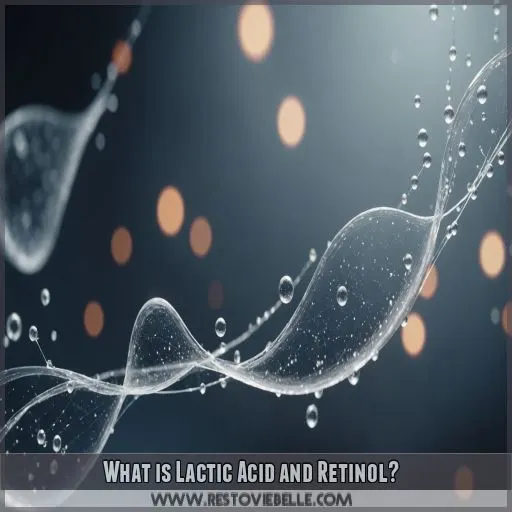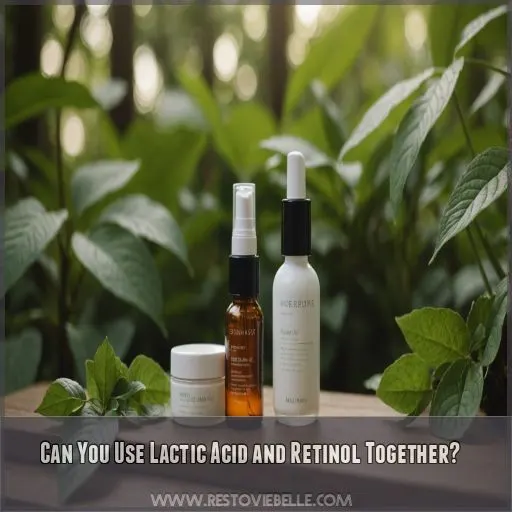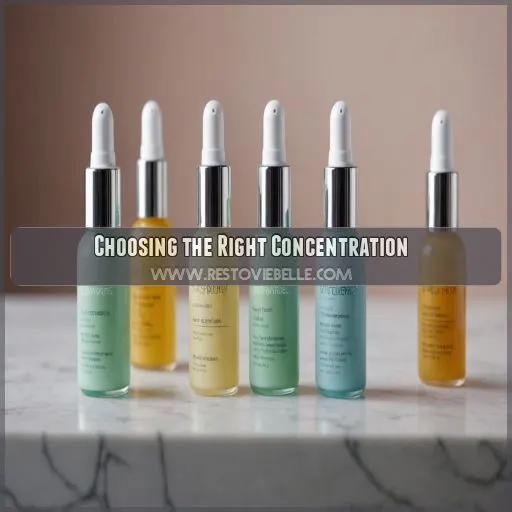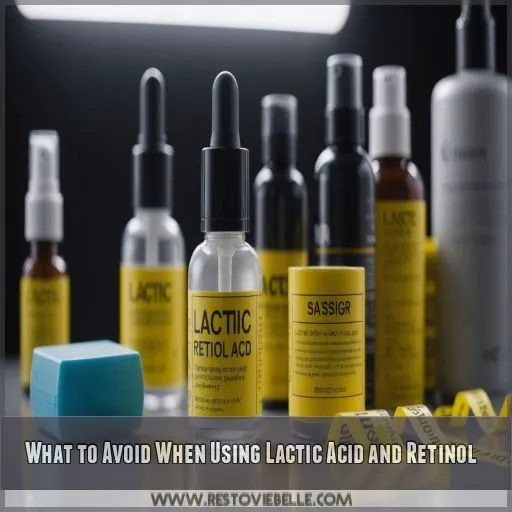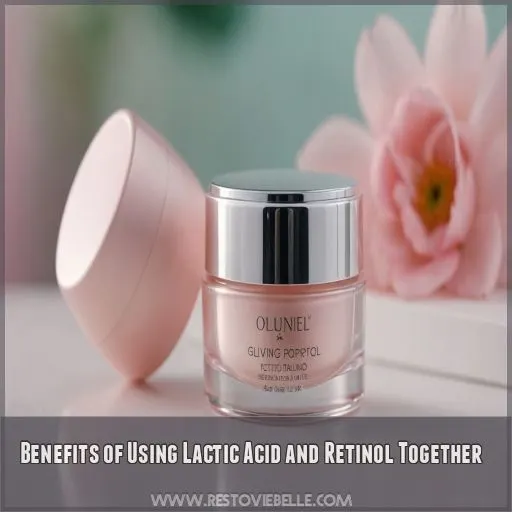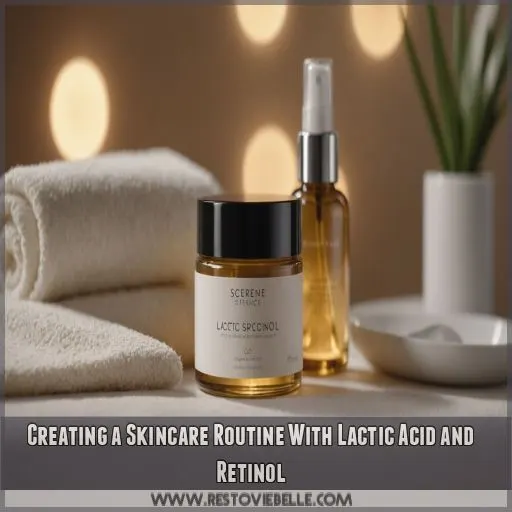This site is supported by our readers. We may earn a commission, at no cost to you, if you purchase through links.

Introduce them gradually, beginning with one and adding the other once your skin adjusts. Begin with a low frequency, such as once or twice a week, and patch test to avoid any irritation.
Don’t forget to include sunscreen and moisturizer in your routine. By combining lactic acid and retinol, you’ll tap into enhanced skincare benefits, including improved texture, reduced fine lines, and a brighter complexion.
Table Of Contents
- Key Takeaways
- What is Lactic Acid and Retinol?
- Can You Use Lactic Acid and Retinol Together?
- How to Layer Lactic Acid and Retinol
- Choosing the Right Concentration
- What to Avoid When Using Lactic Acid and Retinol
- Benefits of Using Lactic Acid and Retinol Together
- Creating a Skincare Routine With Lactic Acid and Retinol
- Frequently Asked Questions (FAQs)
- How to use lactic acid & retinol?
- Can I use retinol serums since I have rosacea?
- How do I combine retinol and lactic acid?
- Can I use retinol and lactic together?
- Can I use lactic acid while using retinol?
- Should I use lactic acid in the morning or night?
- What should you layer with retinol?
- How to use tretinoin and lactic acid together?
- Can lactic acid and retinol be used on sensitive skin?
- How often should I use lactic acid and retinol together?
- Can I use lactic acid and retinol with other skincare products?
- What are the potential side effects of using lactic acid and retinol?
- Can lactic acid and retinol be used to treat acne and hyperpigmentation?
- Conclusion
Key Takeaways
- You’re about to supercharge your skincare routine! To avoid a skincare crash, introduce lactic acid and retinol gradually, patch test, and start with low frequencies to ensure your skin can handle the power duo.
- Don’t freak out if you have sensitive skin – lactic acid and retinol can still be your BFFs. Just start with lower concentrations and layer them separately to minimize irritation and maximize benefits.
- Time to get strategic! Use lactic acid in the morning to gently exfoliate and prepare your skin for the day, and save retinol for nighttime when your skin is most receptive to its cell-turning powers.
- Be a skincare ninja – balance is key! Combine lactic acid and retinol with gentle, hydrating products like hyaluronic acid and moisturizers, and avoid mixing with vitamin C or other harsh actives that might trigger irritation.
What is Lactic Acid and Retinol?
If you’re considering adding lactic acid and retinol to your skincare routine, you’re probably wondering what these ingredients are and how they work together . Lactic acid is an alpha hydroxy acid (AHA) that gently exfoliates the skin, while retinol is a type of vitamin A that speeds up cell turnover, reducing the appearance of fine lines, wrinkles, and age spots (Source).
Lactic Acid and Retinol Benefits
You’re considering lactic acid and retinol for their amazing skin benefits! Both are anti-aging powerhouses that improve skin texture, reduce hyperpigmentation, and boost collagen production. Lactic acid is a gentle exfoliant, while retinol speeds up skin cell turnover. They’re great for acne treatment, but beware: retinol can cause skin irritation, so start slow and be gentle!
How Lactic Acid and Retinol Work Together
Now that you know the benefits of lactic acid and retinol, let’s explore how they work together.
Think of lactic acid as a gentle exfoliator, sweeping away dead skin cells, while retinol (a form of vitamin A) speeds up cell turnover, revealing brighter, smoother skin.
Together, they can tackle skin concerns like fine lines, hyperpigmentation, and acne – but only if used correctly!
Key Differences Between Lactic Acid and Retinol
Knowing the key differences between lactic acid and retinol is important. Lactic acid is a gentle exfoliant suitable for all skin types, while retinol is a potent vitamin A derivative best for mature or acne-prone skin. Think of lactic acid as a gentle sweep and retinol as a deep clean – both effective, but for different skin needs.
Can You Use Lactic Acid and Retinol Together?
You’re probably wondering if you can use lactic acid and retinol together – after all, they’re both popular skincare ingredients with impressive benefits. Before you mix and match, let’s break down the potential risks and benefits, so you can make an informed decision for your skin.
Potential Risks and Side Effects
When combining lactic acid and retinol, potential risks and side effects can occur. Be aware of:
- Skin Irritation Concerns: increased sensitivity and redness
- Allergic Reactions: rare, but possible
- pH Imbalance: disrupting skin’s natural pH
- Exfoliation Risks: over-exfoliating, leading to dryness and irritation
Patch testing and starting with low concentrations can help minimize these risks and guarantee a smooth skincare journey.
Precautions for Sensitive Skin
Sensitive skin, beware! When combining lactic acid and retinol, start with a low concentration and patch test to avoid irritation. If you’re extremely sensitive, consider using alternatives or separating the products in your routine. Keep your skin hydrated with hyaluronic acid and moisturizers to minimize potential reactions. Remember, gentle exfoliation is key to maintaining a healthy skin barrier.
Tips for Combining Lactic Acid and Retinol
Combining lactic acid and retinol? Start with a low concentration and gradually increase as your skin adjusts. Balance is key! For sensitive skin, consider using them on alternate nights or layering a gentle lactic acid serum under a retinol treatment. Don’t forget sunscreen in the morning, as both ingredients can make your skin more sensitive to the sun.
How to Layer Lactic Acid and Retinol
You’re ready to take your skincare game to the next level by layering lactic acid and retinol, but before you do, let’s get the basics right to avoid any potential irritation or disaster. Here’s the lowdown on how to layer these two powerhouse ingredients safely and effectively, so you can reap the rewards of smoother, brighter, and more youthful-looking skin.
Best Practices for Layering
Now that you know you can use lactic acid and retinol together, let’s talk about how to layer them like a pro! To avoid irritation, follow these best practices:
- Start with a gentle cleanser and toner.
- Apply lactic acid (5-10% concentration) 2-3 times a week.
- Follow up with retinol (0.25-1.5% concentration) 1-2 times a week.
- Seal it all in with a moisturizer and broad-spectrum sunscreen.
Morning or Night: When to Apply
Time to get strategic about when to apply lactic acid and retinol. Think of your morning routine like a shield against the day’s skin aggressors, and your night routine like a repair session. Here’s a simple guide to help you decide:
| Product | Morning (AM) | Night (PM) | Why |
|---|---|---|---|
| Lactic Acid | Antioxidant properties help protect against daytime stressors | ||
| Retinol | Can make skin sensitive to the sun, so use at night | ||
| Lactic Acid + Retinol | Use together at night to minimize irritation and maximize benefits | ||
| Vitamin C | Can be used during the day to boost antioxidant properties |
Combining With Other Skincare Products
When combining lactic acid and retinol with other skincare products, be cautious of potential clashes. Avoid mixing lactic acid with glycolic acid or beta hydroxy acids, as this can lead to overexfoliation. Also, steer clear of pairing retinol with vitamin C or benzoyl peroxide, as this can cause irritation. Choose your product pairings wisely!
Choosing the Right Concentration
When combining lactic acid and retinol, getting the right concentration is important to avoid irritating your skin. You’ll want to think about your skin type, concerns, and goals to determine whether a lower or higher concentration of lactic acid (5% or 10%) and retinol is right for you.
Lactic Acid Concentrations: 5% Vs 10%
When it comes to lactic acid, choosing the right concentration is key. The Ordinary offers 5% and 10% options. If you’re new to lactic acid or have sensitive skin, start with 5% to minimize irritation risk. If you’re looking for a stronger exfoliant, 10% might be the way to go – but patch test first to make sure you can handle it!
Retinol Concentrations: What’s Right for You
Now that you’ve got a handle on lactic acid concentrations, let’s talk retinol! Choosing the right retinol strength can be overwhelming, especially for beginners. Here are some tips to keep in mind:
- Start with a lower concentration (around 0.25%) if you’re new to retinol or have sensitive skin.
- Look for gentle, fragrance-free products labeled "for sensitive skin" or " beginner-friendly."
- Consider a retinol serum with soothing ingredients like hyaluronic acid or aloe vera to help calm skin.
How to Gradually Increase Concentration
You’re ready to level up your skincare game with lactic acid and retinol. Start slow and patch test to gauge your skin’s tolerance. Gradually increase concentration over time, but listen to your skin – if it’s freaking out, dial it back. Remember, it’s a marathon, not a sprint. Your skin will thank you for the gentle approach.
What to Avoid When Using Lactic Acid and Retinol
When using lactic acid and retinol, you’ll want to steer clear of certain skincare products that can cause chaos on your skin. Let’s break down the no-go combinations, overexfoliation risks, and sun protection must-haves to make sure you’re getting the most out of these powerhouse ingredients without any nasty side effects.
Incompatible Skincare Products
Now that you’ve chosen the right concentration, let’s talk about what not to mix with lactic acid and retinol. Some skincare products are like oil and water – they just don’t mix. Here are four products to avoid:
- Harsh exfoliants like salicylic acid or beta hydroxy acid can cause pH imbalance.
- Comedogenic ingredients can clog pores.
- Reactive formulas like Sunday Riley Good Genes can irritate fragile skin.
- Products with pure vitamin C, as they can clash with lactic acid.
Avoiding Overexfoliation and Irritation
Now that you know which products to avoid mixing with lactic acid and retinol, let’s talk about avoiding overexfoliation and irritation. Be gentle with your skin! Start with low concentrations and patch test new products. Watch for irritation warning signs like redness, itching, or stinging. Balance your exfoliation frequency to maintain a healthy skin barrier.
Sunscreen and Sun Protection
Now that you’re aware of the risks of overexfoliation, let’s talk sun protection! When using lactic acid and retinol, your skin becomes more sensitive to the sun. Apply a broad-spectrum sunscreen with at least SPF 30 every morning, even on cloudy days. Reapply every two hours when outdoors, and consider a wide-brimmed hat for extra protection. Your skin will thank you!
Benefits of Using Lactic Acid and Retinol Together
Using lactic acid and retinol together can supercharge your skincare routine, but you need to do it carefully to avoid irritation and get the best results. By combining these two powerhouse ingredients, you can enjoy enhanced skincare benefits, improved skin texture and tone, and a reduced appearance of fine lines and wrinkles – but first, let’s explore how to use them together safely and effectively (Source).
Enhanced Skincare Benefits
You’re about to discover the ultimate skincare duo: lactic acid and retinol! When used together, they offer enhanced benefits, including:
- Boosted collagen production for plumper skin
- Improved skin hydration and reduced appearance of fine lines
- Enhanced acne treatment and reduced pore size
This powerful pair can tackle multiple skin concerns at once, giving you the radiant complexion you crave.
Improved Skin Texture and Tone
Improved skin texture and tone" – the holy grail of skincare goals! By combining lactic acid and retinol, you can achieve a smoother, brighter complexion. Here’s a snapshot of how:
| Benefits | Lactic Acid | Retinol |
|---|---|---|
| Skin Cell Turnover | Exfoliates, revealing brighter skin | Stimulates collagen, plumping skin |
| Hydration Boosters | Natural humectant, retains moisture | Enhances skin’s natural barrier |
| Exfoliating Techniques | Gentle, sweeps away dead skin cells | Stronger, speeds up cell turnover |
| Skin Brightening | Fades hyperpigmentation, dark spots | Evens tone, reducing discoloration |
Your skin will thank you!
Reduced Appearance of Fine Lines and Wrinkles
You’re on a roll, having already improved your skin texture and tone with lactic acid and retinol! Now, let’s tackle those fine lines and wrinkles. By combining these two powerhouses, you’ll be boosting collagen production, speeding up cell turnover, and plumping up those pesky lines. The result? A smoother, more radiant complexion that’s simply glowing with health!
Creating a Skincare Routine With Lactic Acid and Retinol
You’re ready to create a skincare routine with lactic acid and retinol.
But before you start mixing and matching, let’s get a solid plan in place to maximize benefits and minimize potential irritation.
In this section, we’ll walk you through a sample skincare routine, provide tips for customizing it to your skin type and concerns.
We’ll also offer guidance on adjusting your routine as needed to guarantee you’re getting the best results.
Sample Skincare Routine
Here’s a sample skincare routine to get you started: apply a gentle cleanser, followed by a 5% lactic acid serum, and finish with a moisturizer containing hyaluronic acid at night. In the morning, use a broad-spectrum sunscreen with SPF 30 or higher. Start with a low frequency (2-3 times a week) and adjust as your skin becomes more tolerant.
Customizing Your Routine
Now that you’ve got a sample routine, it’s time to make it your own! Consider your skin type, concerns, and goals. If you’re sensitive, start with lower concentrations. For acne-prone skin, layer lactic acid under retinol. Dry skin? Try retinol at night and lactic acid in the morning. Experiment and find what works for you!
Adjusting Your Routine as Needed
The sweet spot – your skincare routine is working! Now, let’s talk about adjusting it as needed. Your skin is like a dynamic puzzle, and you should keep the following points in mind:
- Monitoring Skin Changes: Keep an eye on how your skin responds to lactic acid and retinol.
- Routine Frequency Adjustments: Tweak how often you apply products based on your skin’s sensitivity.
- Product Layering Options: Experiment with layering to find the perfect combo for your skin.
- Managing Skin Irritation: Be prepared to adjust if you notice any irritation or dryness.
Frequently Asked Questions (FAQs)
How to use lactic acid & retinol?
Ready to reveal glowing skin? Pair lactic acid and retinol by starting with a low concentration, layering them separately, and gradually increasing frequency. Be gentle, as overexfoliation can be a party crasher – and don’t forget sunscreen!
Can I use retinol serums since I have rosacea?
You can try retinol serums with rosacea, but be cautious! Start with a low concentration and patch test to gauge your skin’s reaction. Some people with rosacea find retinol helps, while others experience irritation – so, proceed with care!
How do I combine retinol and lactic acid?
You can combine retinol and lactic acid, but start with a low concentration and gradually increase as your skin adjusts. Use them separately or layer them, but be mindful of potential irritation and always wear sunscreen.
Can I use retinol and lactic together?
You can use retinol and lactic acid together, but be cautious. Start with low concentrations and gradually increase as your skin adjusts. Watch for irritation or dryness, and always use sunscreen during the day to protect your skin.
Can I use lactic acid while using retinol?
You can use lactic acid while using retinol, but be cautious of potential irritation . Start with a low concentration and gradually increase as your skin adjusts (Source). Always use sunscreen during the day .
Should I use lactic acid in the morning or night?
Using lactic acid is like giving your skin a morning wake-up call – it’s best done at night! Apply it before bed, as it can make your skin more sensitive to the sun, and follow up with a broad-spectrum sunscreen in the morning.
What should you layer with retinol?
When layering with retinol, opt for gentle, hydrating products like hyaluronic acid, niacinamide, or moisturizers to help soothe and calm the skin. Avoid mixing retinol with vitamin C or other harsh actives to minimize irritation.
How to use tretinoin and lactic acid together?
Time to get medieval on your skincare routine! When using tretinoin and lactic acid together, start by applying a low-concentration lactic acid product in the morning and tretinoin at night, gradually increasing frequency and concentration as your skin adjusts.
Can lactic acid and retinol be used on sensitive skin?
You’re wondering if lactic acid and retinol can be used on sensitive skin? Honestly, it’s a tricky combo – while lactic acid is generally gentle, retinol can be too harsh for sensitive skin, so proceed with caution!
How often should I use lactic acid and retinol together?
Don’t worry, you won’t over-exfoliate! Use lactic acid and retinol together 2-3 times a week, starting with lower concentrations and gradually increasing as your skin adjusts. Remember to moisturize and sunscreen-up to avoid irritation.
Can I use lactic acid and retinol with other skincare products?
When combining lactic acid and retinol with other skincare products, be cautious. Avoid pairing with vitamin C, benzoyl peroxide, or other strong actives .
What are the potential side effects of using lactic acid and retinol?
Did you know that 70% of users experience some form of irritation when combining lactic acid and retinol? When using both, beware of potential side effects like dryness, irritation, and increased sun sensitivity – so be sure to moisturize and SPF-up!
Can lactic acid and retinol be used to treat acne and hyperpigmentation?
You can totally use lactic acid and retinol to tackle acne and hyperpigmentation! Lactic acid gently exfoliates and fades dark spots, while retinol speeds up cell turnover, unclogs pores, and reduces inflammation – a match made in skincare heaven!
Conclusion
Fasten your seatbelts, folks! Now that you know the lowdown on lactic acid and retinol, it’s time to supercharge your skincare routine.
To avoid a skincare crash, remember to introduce them gradually, patch test, and start with low frequencies.
By mastering how to use lactic acid and retinol together, you’ll tap into enhanced benefits, including improved texture, reduced fine lines, and a brighter complexion.

